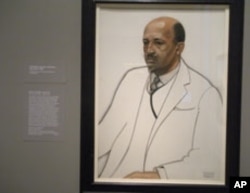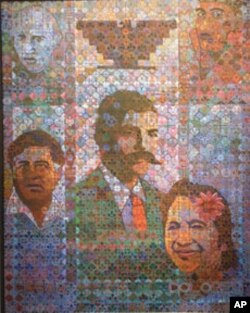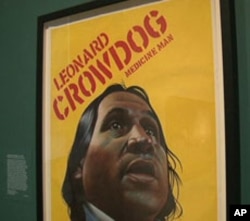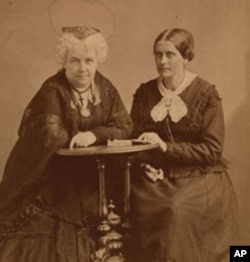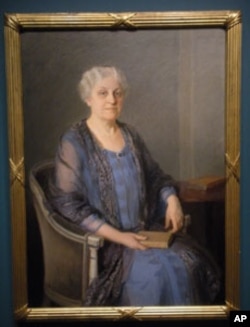On August 28, 1963, a quarter-million Americans marched in the streets of Washington demanding racial equality and freedom. At the time, it was the largest civil rights demonstration in U.S. history.
It was during this march when civil rights champion Martin Luther King Jr. delivered his historic "I Have a Dream" speech advocating racial harmony.
The March for Jobs and Freedom, as it was called, was organized by civil rights activist A. Philip Randolph, who spent a lifetime fighting for the economic empowerment of African-Americans.
Major figures in civil rights history
Randolph and King are among dozens of civil rights leaders showcased in a new exhibit at The National Portrait Gallery in Washington, D.C.
The exhibit features over 40 paintings, photographs, sculptures and other art forms of key figures from the 19th and 20th century who fought to empower African-Americans, women, Native Americans, farm workers, gays, lesbians and the disabled.
There are photographs of slavery abolitionist Frederick Douglass and educator Booker T. Washington, a former slave who went on to become one of the most important African-American leaders of his time.
Sociologist and historian W.E.B. Du Bois, who is portrayed in a pastel portrait, is well known for his ground-breaking book, "The Souls of Black Folk," which described what it was like to be African-American at the turn of the 20th century.
The book is still read by students, black and white, across America.
Opposing approaches to empowerment
Sidney Hart, a senior historian at the Smithsonian National Portrait Gallery, says unlike Booker T. Washington who advocated accommodation and gradualism, Du Bois called for immediate civil and political rights for African-Americans.
Hart says these two leaders represented opposite branches of the African-American struggle for civil rights.
"Two of the most important characters: Du Bois, the Harvard-educated cosmopolitan, cerebral thinker; Washington, born a slave, and working himself up," he says.
Hart says the museum wanted both men featured in the exhibit, "to represent the two opposite poles of civil rights."
In 1955, Rosa Parks was arrested when she refused to give her seat to a white male bus rider in Montgomery, Alabama. This sparked a boycott of the city's bus system.
The following year, the U.S. Supreme Court ruled that laws requiring segregation on buses were unconstitutional.
Parks is featured in the exhibit in a large, wooden sculpture where she is seen being held by two policemen. Parks is painted in bright primary colors, and is proportionately larger than the other two figures, who've been painted in more subdued colors.
Farm workers unite
The exhibit also features César Chávez, a Mexican-American farm worker who led a series of protests in the 1960s against the unfair treatment of migrant workers. He and fellow activist Dolores Huerta co-founded the United Farm Workers (UFW) which launched a nationwide boycott of California grapes to improve working conditions for grape pickers.
According to Ann Shumard, curator of photographs at The National Portrait Gallery, their movement expanded well beyond the West Coast to become a nationwide organization supporting labor opportunities and rights for migrant and agricultural workers.
Chavez and Delores Huerta are commemorated in a painting called "The Return to Aztlan," which also depicts images of Emiliano Zapata, leader of the Mexican revolution, and Jose Maria Morelos and Miguel Hidalgo, both leaders in the war for Mexican independence.
Native Americans are "still here"
Leonard Crow Dog fought for greater rights for Native Americans and is regarded by many as the spiritual leader of the American Indian Movement (AIM), an organization of Native American activists that was founded in 1968.
Crow Dog is represented in the exhibit through a poster bearing his image.
According to Frank Goodyear, associate curator of photographs at The National Portrait Gallery, the poster was part of the publicity materials that the American Indian movement generated.
There is a slogan under Crow Dog's portrait that reads, "We are still here," which Goodyear explains was a symbolic reminder to Americans that Native Americans had not vanished; that these tribal communities were still present, but simply lacked visibility in the larger American public.
According to Goodyear, Crow Dog not only advocated demonstrations to promote Native American rights, but also encouraged Native Americans to "re-engage with their traditions."
"He suggested the importance of Native Americans looking back to their heritage, to their traditions and finding strength in that history," he says.
Goodyear says it was largely because of the efforts of the American Indian Movement that Congress passed the "Indian Self-determination and Education" act in 1975.
"A landmark piece of civil rights legislation that reasserts tribal sovereignty, and establishes the tribal college system which remains today a really important element in Native American communities," he says.
Women get the vote
In 1920, after a long and difficult struggle, American women finally gained the right to vote.
The seeds of that historic victory were sewn by women's rights activists Lucretia Coffin Mott, Elizabeth Cady Stanton and Susan B. Anthony.
They are represented in the exhibit through historic photographs.
There is also a large oil painting of Carrie Chapman Catt, another leading figure in the women's rights movement. In 1900, she replaced Anthony as president of the National American Woman Suffrage Association (NAWSA).
It was Catt who led the organization during its successful passage of the 19th Amendment in 1920, which guaranteed all American women the right to vote.
The heroic individuals showcased in this exhibit fought hard to achieve justice and equality for their fellow Americans.
They are remembered not only for the battles they waged but for the groundwork they laid for struggles that remain to be won.






